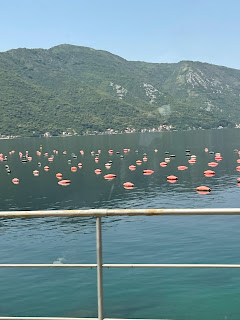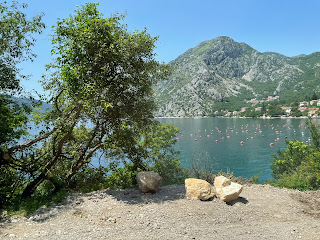Day 3: Montenegro and the Bay of Kotor
This morning Mario picked us up along with our guide for the day, MiloŠ (Milosch), for our first border crossing into neighboring Montenegro. Montenegro is bordered by not only Croatia, but by Serbia Albania, Bosnia and Herzegovina as well. The area was 1st settled by Illyrians and later in the 7th Century invaded by Slavs. In 1910, the country became a kingdom. After World War I, the kingdom became part of Yugoslavia. Following the breakup of Yugoslavia, the republics of Serbia and Montenegro together proclaimed a federation. In June 2006 Montenegro declared its independence from Serbia and Montenegro following an independence referendum, creating Montenegro and Serbia as they exist today.
Our destination was the Bay of Kotor. We were warned that the border crossing could take an hour or two but for whatever reason, we breezed through.
The Bay of Kotor is about 17 miles long with roughly 67 miles of coastline. It has been ranked by travel sources as one of the top 50 places to see before you die. The region is very reminiscent of the Norwegian Fjords (though about 30° warmer). The bay is surrounded by 1,000 foot mountains that extend directly into the water.
 |
| Bay of Kotor |
Oyster and mussel farms can be seen at every turn. The road followed the coastline giving us stunning views for the entire trip.
 |
| Oyster Farm |
Our first stop was the small town of Perast from which you could see two sister islets in the bay, the tiny islet of St. George on which is a Benedictine Monastery from the 12th century, and the larger (though man-made) islet of the Our Lady of the Rock. It is forbidden to set foot on St. George with the exception of on one special holy day each year.
Our Lady of the Rock, on the other hand, has small tour boats traipsing back and forth about every ten minutes.
Our Lady of the Rock is an artificial island begun as small rocks on which captured ships loaded with rocks (and hopefully no crew members) were sunk. According to legend, the islet was made over the centuries by local seamen who kept an ancient oath after finding the icon of Madonna and Child (in 1452) on the rock in the sea. Upon returning from each successful voyage, they laid a rock in the Bay. Over time, the islet gradually emerged from the sea. The islet now houses a small church and museum.
The sides of the altar in the church were adorned with bouquets of varying degrees of freshness (and I mean varying). MiloŠ 's wife's wedding bouquet (from two years ago) was still there! Even if you are not married in the church, couples often brought there wedding bouquet here for good luck.

We planned a gelato run after returning to dry land in Perast, but the flavors weren't up to our standards, so we decided to hold out for better in Kotor.
Kotor is a fortified town below the limestone cliffs of Mt. Lovćen. Its medieval old town is characterized by winding streets and squares.
The port of Kotor is surrounded by fortifications built during the Venetian period.
We entered through the Main Gate and meandered through the old town with a few thousand of our closest friends. Cruise ships dock here (as many as 8 in high season-we only had 3).
 |
| David and MiloŠ at the main gate |
 |
| Cathedral of Saint Tryphon |
 |
| St. Lukes's Church (Eastern Orthodox) |
After extricating ourselves from the masses, we walked through the open air market where some of us bought fruit, but overall was not that impressive. Jeri and I were starving, so Rich, Suzy, Jeri and I broke ranks and found a couple of slices of pizza followed shortly thereafter by a dose of gelato.
Reinvigorated, we re-boarded our sprinter for our return to Croatia and our last night at the Hotel Kompass.























No comments:
Post a Comment